Why is email marketing so enticing to marketers? It’s a relatively free channel that you control entirely. You can reach the desired audience directly with personalized content, free from the constraints of social media or search engine algorithms. Plus, it typically offers a decent ROI (between $36 to $40 for every dollar spent). Sounds great, right?
However, it’s not only about sending out your weekly news, discounts, or product launch announcements. With an email funnel, you can guide potential customers smoothly from point A to point B. It keeps your leads on course, preventing them from getting lost along the way.
In a perfect scenario, paying customers become your best brand advocates. Their love for your product or service quickly turns into referrals. This, in turn, leads more people to your brand. That’s where an email marketing funnel is indispensable.
It ensures you send the right emails that match the different stages of your subscribers’ buying journey. But how do you create a funnel that doesn’t leak leads? That is a science as well as an art.
This article will guide you through the process of building an email marketing funnel. You’ll learn how to address the needs and pain points of both potential and existing customers at each stage of the marketing funnel. You’ll get actionable insights and best practices for creating high-converting email campaigns.
Understanding Email Marketing Funnels
For starters, what is an email marketing funnel, and why is it so important? An email marketing funnel is a strategic model that guides potential customers through their buying journey, from initial awareness to becoming loyal customers.
The thing is that the customer journey consists of different stages, regardless of the channel used:
An email funnel, in particular, revolves around sending the right emails to prospects according to their place in the journey. That is, a potential customer who is about to purchase needs a different type of nudge than the one who just subscribed to your email newsletter.
An email sales funnel benefits marketing efforts in various ways:
Suppose a person discovers your product or service through an engaging opt-in form. This is the awareness stage. To keep them interested, you need to employ an efficient marketing funnel. For example, send targeted content, a welcome email, and educational content that addresses their pain points.
Take a look at the screenshot below. Cocofloss’s marketing team came up with a warm and engaging welcome email, making new subscribers feel part of the Cocofloss family. The email offers a 10% discount with a clear CTA to use the code, incentivizing immediate purchases.

Screenshot taken from the newsletter from the official Cocofloss website
If prospects are further in the funnel, in the consideration or conversion stage, you can already deliver promotional emails to convert subscribers into customers. And the buyer’s journey continues.
However, the stages of your funnel may not always perform smoothly. That’s why it’s advisable to perform a conversion rate audit to identify and address any inefficiencies.
Stages of an Email Marketing Sales Funnel: From Visitors to Paying Customers
Now, let’s dissect the email marketing funnel and overview each stage in greater detail.
Awareness
The awareness stage is where it all starts, i.e., the initial email received by prospective clients. Here, you present your company to people and generate leads.
Note: It’s not the place for aggressive offers. Actually, even if you’re an eCommerce store, you shouldn’t try to sell anything, as there’s a good risk that your leads will disappear right away.
Instead, use a lead magnet to collect email addresses:
Interest (or Engagement)
Next comes the interest stage. A fantastic method to drive the interest of potential clients is to provide educational materials through lead-nurturing emails, such as blog posts, how-to manuals, eBooks, tutorials, etc. The objective is to establish authority. To reiterate, you still shouldn’t be selling anything. This stage is all about building a relationship and demonstrating your brand’s value.
TurboTax employs several effective engagement techniques in its email sales funnel, namely:
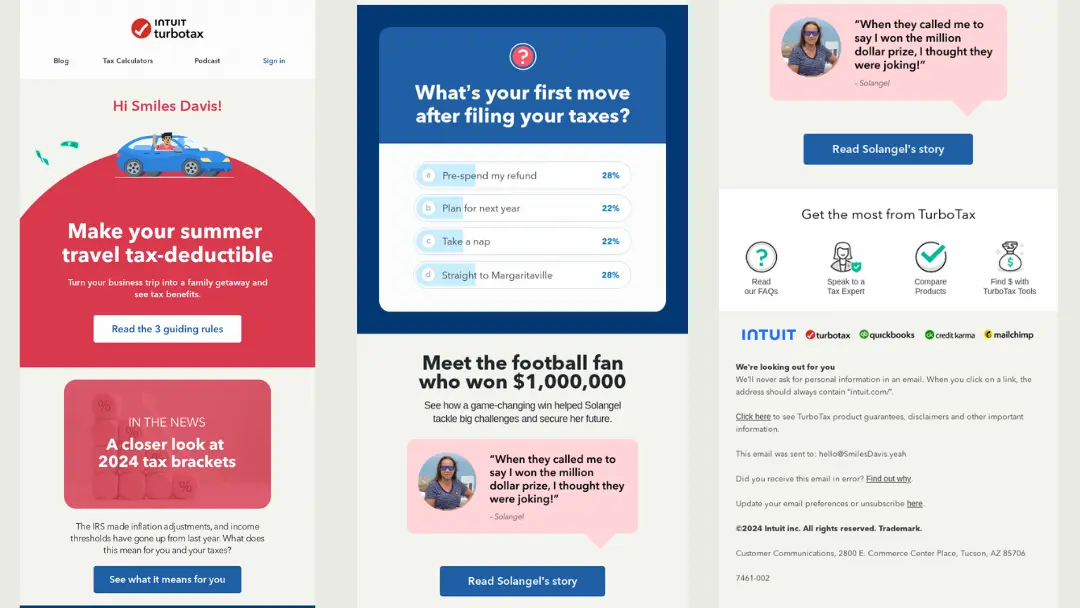
Screenshot taken from the newsletter from the official TurboTax website
Consideration
Once curiosity is piqued, your subscribers will begin to discover more about your company and products. This is a consideration stage. Here, you argue that your product is the most effective. Your customer is currently screening you against the competition and their own personal obstacles (like lack of trust or finances). Highlight the unique benefits of your offering, share customer testimonials, and showcase case studies.
At this step, you need to do the same thing your subscribers are doing—learn. About your clients. Segment your email subscribers, send personalized messages, and see what resonates best.
As demonstrated in the following screenshot, Livestorm gathers valuable insights from its subscribers by asking them to participate in a survey.
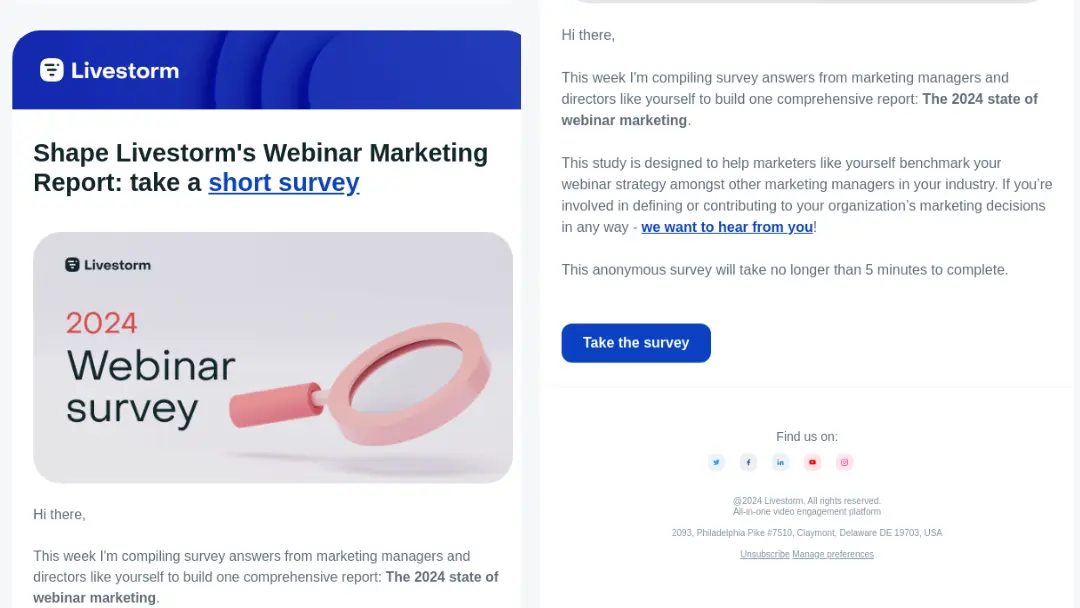
Screenshot taken from the newsletter from the official Livestorm website
Conversion
This is the point at which prospective clients turn into actual, new customers. They’ve determined that your product offers the best possible solution. Now, they require a clear call to action (CTA) and step-by-step instructions on how to gain access to your goods.
You can minimize roadblocks with the following tools:
A case in point is Dollar Flight Club. The company creates a sense of urgency right from the start, the subject line (”🚨$1 Offer Ends in 6 Hours…”), prompting recipients to act quickly. The copy reinforces this idea (“Try Premium Plus+ for $1 (offer ends today)” and “Try for $1 today”).

Screenshot taken from the newsletter from the official Dollar Flight Club website
Yet, don’t overuse some strategies, especially the time-limited offers. Such offers may be viewed as overly pushy andsalesy in certain spheres, where the target audience may not accept them.
Retention and Advocacy
The buyer journey doesn’t end when a lead purchases goods for the first time. You still need to build a stronger relationship with them so they will return and refer others to your business. Customer retention is essential, as persuading existing customers to buy is cheaper than acquiring new ones.
Successful email marketing strategies at this stage include:
Your task is to build customer loyalty so that your loyal customers will start referring others. That’s where you need to sustain the high quality of your products or services. To ensure it, collect feedback and act upon the suggestions.
Ray-Ban demonstrates a successful email funnel and fosters customer loyalty by adding a personal touch. Not only does the email ask a user to share their birthday, but it also offers a birthday gift and makes shoppers feel valued and appreciated. Such emails are unlikely to end up in spam folders.
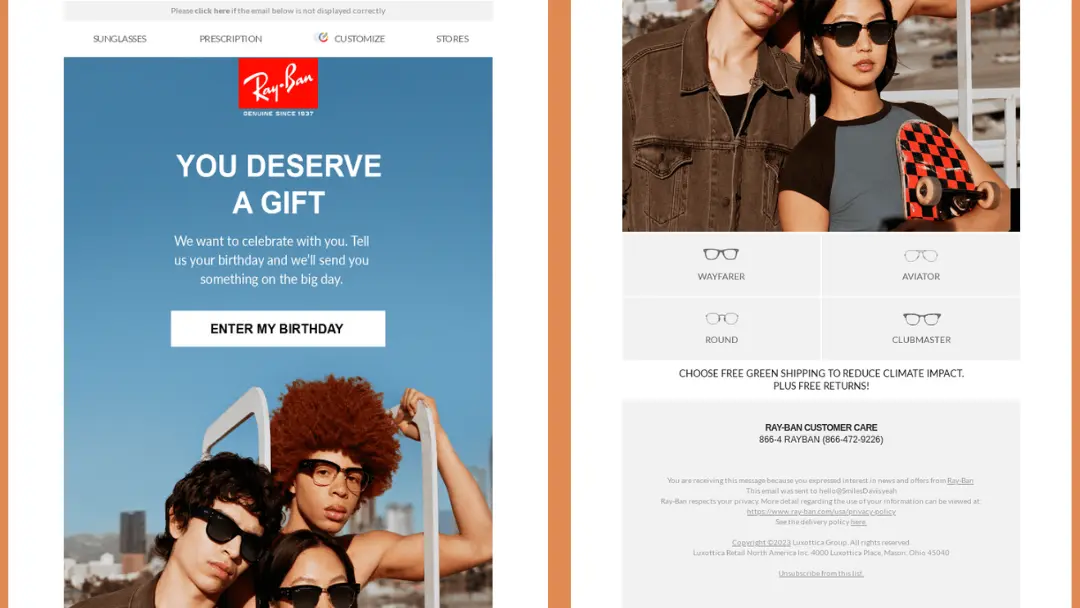
Screenshot taken from the newsletter from the official Ray-Ban website
Planning Your Email Marketing Funnel for a Seamless Customer Journey
Let’s discuss some preparatory steps for developing an effective email marketing funnel. This stage comprises three crucial actions:
Use data-driven marketing funnel analysis to fine-tune your approach, ensuring each stage is not only aligned with your goals but also optimized for better engagement, conversion, and overall effectiveness.”
How to Build an Email Marketing Funnel
Creating Awareness
As mentioned above, the best way to grab attention is through lead magnets and content offers. A lead magnet is something valuable a person gets in exchange for giving you contact information. Plus, use social proof and authority, including testimonials, user-generated content, and industry accolades.
As illustrated in the screenshot below, Stitch Fix effectively employs this advice in its email marketing campaigns.
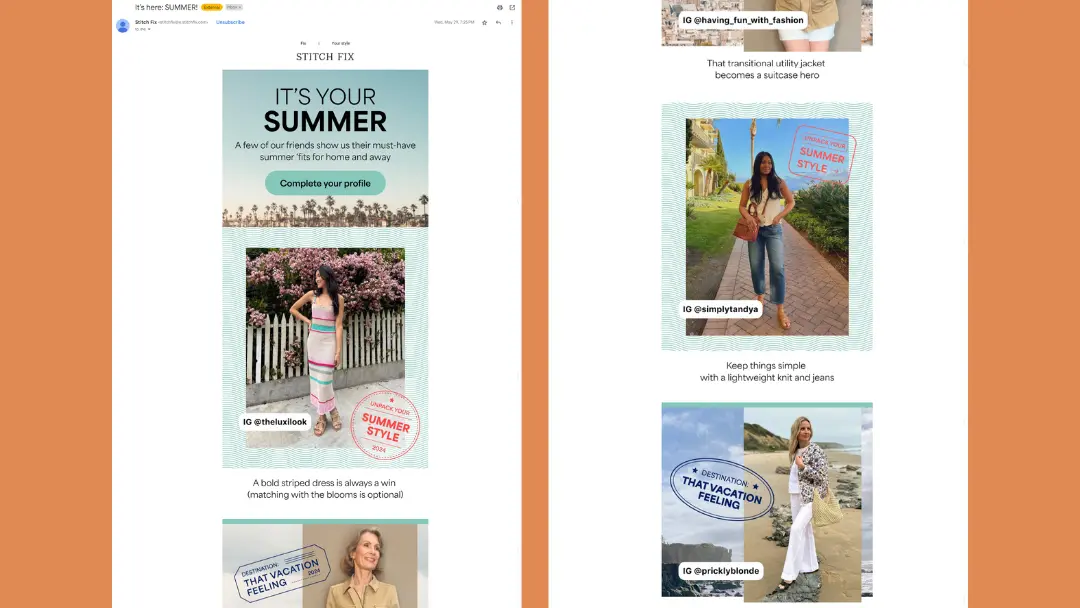
Screenshot taken from the newsletter from the official Stitch Fix website
Capturing Leads
Lead capture is the process of obtaining information from your potential clients. If a person leaves their details, this indicates a higher interest in your company and, thus, more chances for conversion. Provide a place for users to submit their information, that is, opt-in forms. You can capture leads everywhere: on a website, social media, emails, blog posts, etc. Just follow these best practices:
Nurturing Leads
Lead nurturing entails establishing rapport with potential customers in order to secure a sale when they’re ready. Drip campaigns and autoresponders are invaluable tools here.
What’s a drip campaign? It’s a series of emails sent over time. Autoresponders, on the other hand, are automated emails triggered by specific actions, like signing up for a newsletter or downloading a lead magnet. You can set those up with the help of marketing automation tools like Drip, ActiveCampaign, Sender, Omnisend, and others.
Remember that it’s possible to keep people engaged only with relevant content. Thus, analyze customer behavior and serve personalized content based on consumers’ specific needs.
Converting Leads into Customers
At this point, your content should be persuasive, succinct, and CTA-driven. There should be no hesitation, so alleviate final objections before asking for the sale.
Is your campaign time-sensitive? If so, it’s the best place to tell subscribers about it. Don’t forget to mention any time-limited deals in both the email body copy and the subject line. A CTA should be clear and direct and encourage immediate action, like “Buy Now,” “Get Started Today,” or “Claim Your Discount.”
Calm employs several powerful CTAs in its email marketing efforts, such as “Claim 40% off now,” “Listen for free now,” and “Breathe in.”
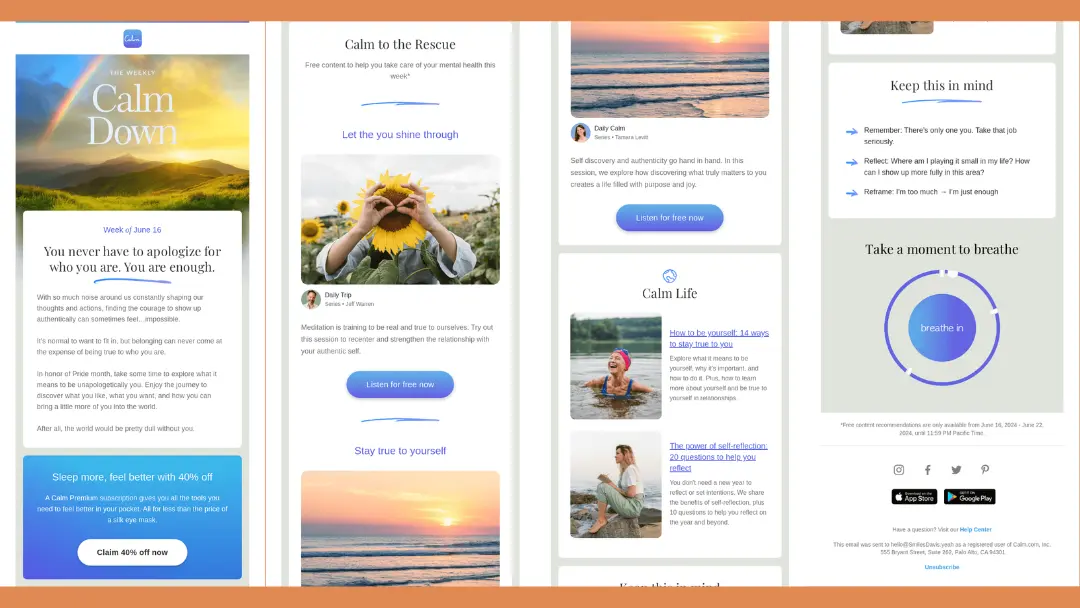
Screenshot taken from the newsletter from the official Calm website
Retaining Customers and Building Loyalty
Give people reasons to keep opening your emails even after a purchase. That’s where you should also take care of the content relevance and personalization. Moreover, make consumers feel special. Create a loyalty program and give exclusive access to products, events, or content.
Tips:
The Webster combines two personalization tactics—an abandoned cart email and a section called “You May Also Like”—to win over a customer and increase order value at the same time.
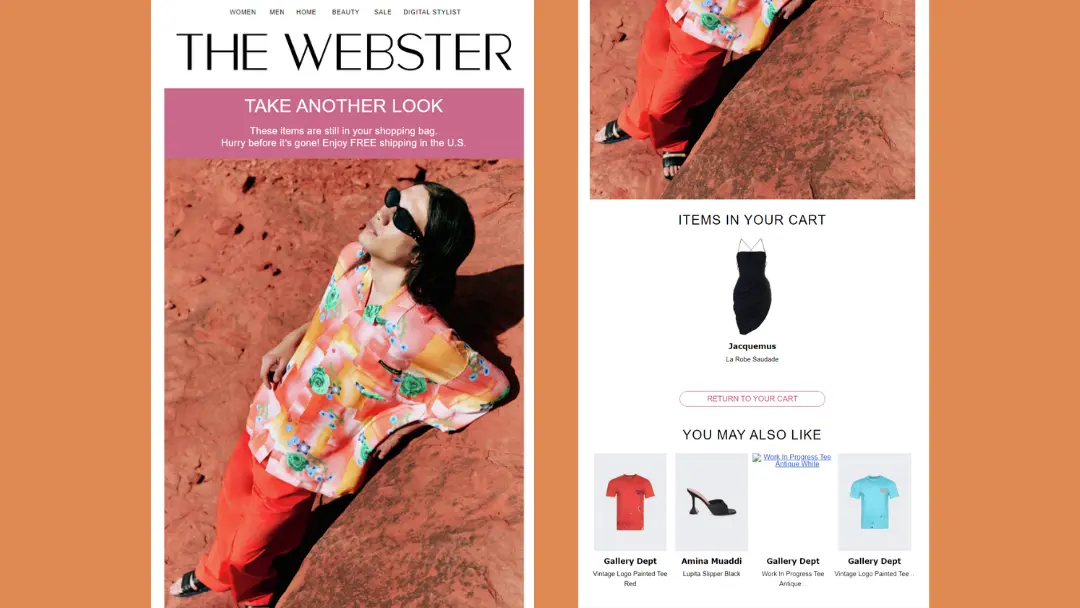
Screenshot taken from the newsletter from the official The Webster website
Designing an Email Marketing Funnel: Final Word
As you can see, crafting a high-converting email marketing funnel is no small feat. At GoZen, we get it. Our platform offers robust sales automation and email marketing tools. These solutions streamline your marketing campaigns, nurture leads, and retain customers. Want to capture leads with engaging opt-in forms? Or craft personalized emails that resonate with your audience? We’ve got you covered.
Now that you’ve got ideas for optimizing your email marketing strategy, it’s time to implement the knowledge you’ve acquired. Share valuable content, employ email automation tools, design dedicated landing pages, and see your click-through rates skyrocket!



